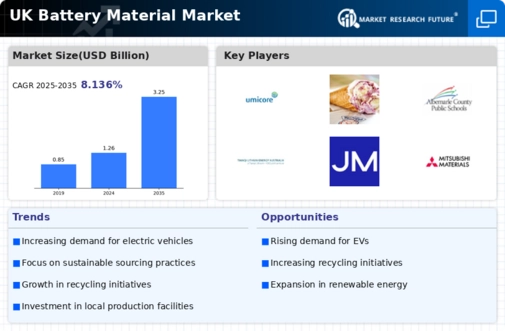The UK Battery Material Market has become increasingly vital as the demand for electric vehicles, renewable energy solutions, and portable electronic devices continues to rise. This growing emphasis on sustainability and reduction of carbon emissions has spurred significant investments in battery technologies and materials crucial for producing efficient and long-lasting batteries. A competitive landscape has emerged, characterized by both established players and new entrants striving to capture market share. Companies in this sector are focusing on innovative material development, strategic partnerships, and expanding production capacities to address the evolving needs of various industries reliant on battery technologies.
Amidst this dynamic environment, understanding the competitive insights within the UK Battery Material Market is essential for stakeholders aiming to navigate challenges and seize opportunities. Livent stands out in the UK Battery Material Market due to its robust technological capabilities and deep industry expertise. The company has honed its focus on lithium hydroxide and other key materials essential for the production of advanced battery chemistries. Livent has established a commendable market presence by offering innovative solutions that cater to the specific demands of electric vehicle manufacturers and energy storage systems in the UK.
One of the strengths of Livent is its commitment to sustainable practices, which resonate well with the growing consumer demand for environmentally friendly products. Furthermore, Livent’s ability to leverage its strategic partnerships with various automotive and technology firms ensures that the company maintains a competitive edge in this rapidly evolving marketplace. Umicore's influence in the UK Battery Material Market is significant, particularly due to its broad range of products and services focused on battery components and recycling. The company specializes in advanced materials essential for lithium-ion batteries, emphasizing efficiency and sustainability in its manufacturing processes.
Umicore's key products include cathode materials, which are crucial for enhancing battery performance, and its recycling capabilities that support the circular economy. The company possesses a strong market presence, bolstered by its ongoing investments in technology and research, enabling it to stay ahead of competitors. With a series of collaborations and strategic mergers, Umicore continually enhances its service offerings and market reach, further solidifying its position in the UK as a leader in the battery material sector.
The strengths of Umicore lie in its commitment to sustainable practices, innovation, and its ability to adapt to the changing landscape of battery technologies.



















Leave a Comment